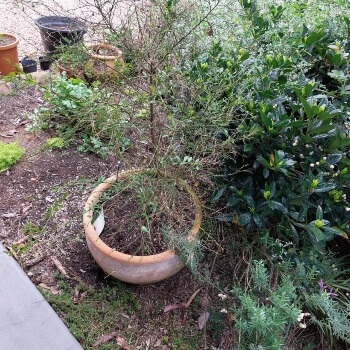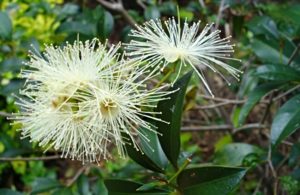Vit K.
We just moved in to new home a few months ago and buy chance i discovered there is a finger lime growing in a pot, IT IS THE MOST ORNERY NASTY VINDICTIVE AND UGLIEST PLANT i have ever encountered. I have read all here about pruning but i look at this thing and it just looks all wrong.
I simply cant figure it out!!! Many spindly branches and they look brown and dead but half way along many turn green, but there are literally no lush leaves like in many of your pics?.
I think a picture(s) is worth many words and i feel if you see this thing i hope you might advise me how to nurture it??
Thank you in advance
Vit K.

Vit K's finger lime finger lime growing in a pot

Vit K.
I think its hard to see clearly because of the greenery in the background but all/most of the brown twigs you see have green tips.
Really appreciate if you can advise if it can be saved and bear fruit.
Gary Clarke
Hi there Vit,
I can see where your concern lies. Your newly adopted finger lime does look like it’s struggling quite a bit. Recovery can be possible but not always guaranteed, unfortunately. Based on the pictures and the fact there are some healthier green branch tips, I do believe there are some ways in which you can help restore your tree.
It’s good to note that finger limes are known to lose their leaves for longer periods and they can normally recover with some extra care. They are also known to grow a little unruly if left unkept.
I’m not sure what measures you’ve taken thus far but I would personally start by repotting the tree into some fresh soil and then watering it in well. Finger limes should be repotted every 2 to 3 years to ensure the soil remains filled with nutrients and drains properly.
The best soil would be a rich, citrus-specific mix or a high-quality planting soil mix with good drainage. If that current container is not draining the soil well enough, I would consider also repotting into a new container with better drainage (and even adding a layer of pebbles at the bottom).
Your finger lime will appreciate regular water now going into the summer months so try to check the general moisture of the soil every 2 to 3 days and if it feels dry, add some water.
You can then consider cutting back some of the older dead or damaged branches to help encourage new green growth as seen in some of the other areas in your tree. Try not to cut away too much at once but lightly trim away bit by bit to slowly help healthier branches develop.
I would recommend trying to expose the tree to a little more light in a sheltered location away from strong winds. Fruiting trees love plenty of daily dappled light. You can optionally add some coarse mulch around the base to help with moisture retention in the coming warmer months.
Give your tree some time to adjust to the new care routine and hopefully, it can recover after the active season next year sometime. Should all else fail, I would say perhaps buying a new young and healthy finger lime from a local nursery or gardening centre would be a good option to consider.
You can then ensure it grows with the proper care needed for a thriving fruiting tree.
I hope this information proves useful and you’re able to save your tree Vit.
Happy gardening!
Vit K.
Gary,
Thank you so much for your information, really appreciate your time and information. Regarding the pruning, almost all the branches look dead from the stem and then have green tips, should I prune these???
Gary Clarke
Hi Vit,
Not a problem at all, I'm glad I could offer some hopefully helpful advice.
Regarding the pruning, I would recommend leaving most of the green-tipped branches as is. As you say, most are dead at the bottom and become green at their ends so I would lightly cut away the worst of them and leave the healthier branches.
Hopefully, over time, your finger lime can fill out with more healthy growth.
Gary
Vit K.
I fear you my have misunderstood my meaning re the branches. There really NO DEAD BRANCHES. Most sprout out from the trunk and are brown and looking like completely dead but then as the branch progresses the colour changes from a dead looking brown to green and ends up green at the tip.
So this is how most branches are on the plant, do I still trim and if so which parts.
Thank you again.
Gary Clarke
Hi Vit,
Yes, I could see in the pictures that most if not all of the branches start out looking quite dead then become green towards the ends with almost fully green tips. It is a peculiar growth habit indeed.
I would still recommend lightly trimming away the worst of them, even if it’s bit by bit. Cut the branches towards the base of the plant. This should help stimulate new, healthy branch growth and hopefully some new foliage eventually.
I would keep the majority of the best-looking branches as is and see how the finger lime responds over time. If you’re not too comfortable with trimming just yet, perhaps try some of the other tips I mentioned in the meantime and see how it goes from there.
I hope you can get your finger lime back to good health soon.
Gary Clarke
Hi again Vit,
I've been doing a little more digging into what could be causing the browning branches with green tips and it seems finger limes respond this way under stress. This is also why it is defoliating. This would make sense seeing as the plant was probably a little neglected before your arrival.
I think it would be best to just leave the branches as is for now. Repot into some fresh soil, fertilise and see how the plant responds moving forward. I think with some regular TLC, the plant will be able to recover and pruning may not be necessary right now until new growth has appeared in the coming seasons.
Hope this helps.
Vit K.
Gary,
Thank you so much for the invaluable advice.
I hope I am not pushing my luck here but any advice how to get it out of this clay pot which sort of tapers at the top??
And also, should I plant in a bigger pot or just refresh the current pot with soil (if I can get the plant out???)
Gary Clarke
Hi there Vit,
I hope your finger lime is slowly coming back to life.
For its removal and repotting, here is what I would recommend:
- Start by drenching the existing soil in its current container. This will help loosen the soil surrounding the root ball which should make it easier for you to extract.
- Place an old mat or rug next to the container and gently tilt it so it lies on its side.
- Using a spade, shovel or even a long gardening saw, gently tease the soil around the circumference of the current container, getting as deep as you possibly can into the container. (Some force may be required if the soil is very compacted).
- Once the soil has loosened, use your hands to gently pull on the main branch to release the tree and root ball from the container.
Once the tree is free from the old container, try removing as much of the older soil as possible without disturbing the root ball.
I would highly recommend repotting your finger lime into a slightly larger container with fresh soil. This will give the roots and the plant as a whole enough space to develop new healthy growth in the coming seasons.
Here are a few videos we found that may also help with the repotting process:
https://www.youtube.com/watch?v=8SsT5V4gAIs
https://www.youtube.com/watch?v=nQT3yfhzsI8
Wishing you the very best of luck Vit.
Gary Clarke
Vit K.
Wow, thank you so much gary, really appreciate the information.
Published on September 27, 2023 by Gary Clarke
Last Updated on January 31, 2024




